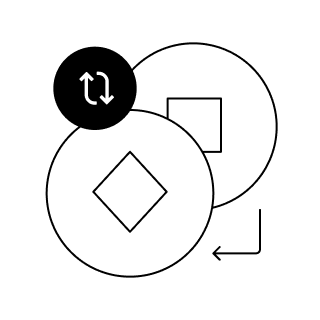What’s Tether (USDT)? How can I buy it?
What is Tether?
Tether (USDT) is a fiat-collateralized stablecoin designed to maintain a 1:1 value with the U.S. dollar. Issued by Tether Limited (affiliated with iFinex, which also owns Bitfinex), USDT aims to provide the price stability of traditional currencies with the programmability and settlement speed of crypto networks. As of 2025, USDT is the most widely used stablecoin by market capitalization and trading volume, serving as a primary quote and settlement asset across centralized exchanges (CEXs), decentralized finance (DeFi) protocols, and cross-border payment rails.
The core promise of Tether is that each token is backed by reserves held by the issuer. While USDT was originally launched on the Bitcoin Omni Layer in 2014, it has since expanded to multiple chains including Ethereum (ERC-20), Tron (TRC-20), Solana, Algorand, Polygon, and others, making it broadly accessible across crypto ecosystems.
How does Tether work? The tech that powers it
-
Issuance and redemption
- Authorized counterparties (typically exchanges, fintechs, and institutions) can deposit USD or eligible equivalents with Tether Limited to mint new USDT.
- Conversely, they can redeem USDT for dollars (or wire transfers) by returning tokens to the issuer. This arbitrage-based mechanism helps keep secondary market prices near $1, as deviations can be exploited by authorized participants.
- Retail users generally acquire or redeem USDT via exchanges rather than directly with Tether Limited.
-
Reserve backing and attestations
- Tether states that USDT is fully backed by reserves consisting of cash, cash equivalents (notably short-term U.S. Treasury bills), secured loans, precious metals, Bitcoin, and other investments.
- Tether publishes regular reserve attestations by an independent accounting firm (e.g., BDO Italia) to report the composition and excess of reserves over liabilities. These are attestations (point-in-time reports), not full audits. Over time, Tether has shifted a large share of reserves into short-term U.S. Treasuries and cash equivalents, increasing liquidity and reducing credit risk relative to earlier periods.
- The company also reports a “consolidated reserves report” (CRR) and has emphasized maintaining a material excess of reserves over circulating USDT.
-
Multichain token model
- USDT is a token standard implemented differently across chains:
- Ethereum: ERC-20 smart contract with standard transfer/allowance functions.
- Tron: TRC-20 contract offering low fees and fast settlement; a large share of USDT circulation now occurs on Tron due to cost efficiency.
- Other networks: Implementations follow the host chain’s token standards, enabling compatibility with wallets and DeFi protocols on those networks.
- Tether uses chain-specific token contracts it controls. The issuer can coordinate mints/burns and, on some chains, exercise administrative functions such as freezing addresses in response to law enforcement requests or sanctions compliance.
- USDT is a token standard implemented differently across chains:
-
Price stability mechanism
- Unlike algorithmic stablecoins that use on-chain algorithms and collateral ratios, USDT’s peg rests on off-chain reserves and the credibility of redemption. Market makers help stabilize price around $1 by exploiting arbitrage opportunities between exchanges and the issuer’s mint/redeem window.
- In stressed markets, secondary market prices can deviate slightly from $1, but historically revert as arbitrage and redemption flows normalize.
-
Compliance and controls
- Tether maintains compliance processes for KYC/AML with direct counterparties and may freeze assets associated with illicit activity, court orders, or sanctions lists. Blockchain transparency allows monitoring of token movements, while administrative controls enable targeted enforcement.
-
Settlement and integrations
- Because USDT lives natively on multiple chains, it can settle in minutes or seconds, 24/7, across borders, without correspondent banks. It is widely integrated into:
- Centralized exchanges as a base pair for trading.
- DeFi protocols for lending/borrowing, liquidity pools, and yield strategies.
- Payment and remittance services in emerging markets where dollar access is constrained.
- Because USDT lives natively on multiple chains, it can settle in minutes or seconds, 24/7, across borders, without correspondent banks. It is widely integrated into:
What makes Tether unique?
-
Scale and liquidity
- USDT is the largest and most liquid stablecoin, often representing the majority of stablecoin trading volume. This depth makes it a preferred quote currency and hedging instrument.
-
Multichain dominance and low-cost rails
- Tether’s extensive support across chains, especially Tron (TRC-20), has driven global usage where low fees and speed are essential. This multichain footprint enhances accessibility and redundancy.
-
Conservative shift in reserves
- Following past scrutiny, Tether has increased the share of highly liquid, short-duration U.S. Treasuries and cash equivalents in its reserves, as reflected in periodic attestations. It also reports surplus reserves (equity) over circulating liabilities, intended to provide an additional buffer.
-
Operational responsiveness
- Tether has demonstrated an ability to freeze compromised funds, coordinate with authorities, and execute large-scale mints/redemptions during market stress—capabilities that are operationally complex at global scale.
-
Market infrastructure role
- USDT functions as a bridge between traditional finance and crypto markets, enabling dollar-denominated pricing and settlement in jurisdictions and platforms where direct USD rails are limited.
Tether price history and value: A comprehensive overview
-
Peg behavior
- USDT is designed to trade near $1. Historically, secondary market prices have ranged within a narrow band around the peg, with brief deviations during market-wide stress or liquidity dislocations. These deviations are typically corrected through arbitrage and redemption flows.
-
Growth in circulation
- USDT’s circulating supply has expanded significantly since 2017, reflecting demand from exchanges, traders, and emerging-market users seeking dollar exposure. Growth has often accelerated during crypto bull markets and in periods of heightened macro uncertainty when dollar demand rises.
-
Reserve evolution and transparency
- Earlier in its history, Tether faced criticism over the composition and disclosure of reserves. Since 2021–2023, attestations have detailed a higher proportion of short-term U.S. Treasuries and cash-like assets, a reduction in commercial paper exposure, and the presence of additional reserves beyond liabilities. These changes coincided with broader market demand for higher-quality collateral post-2022.
-
Yield dynamics
- Because a large portion of reserves is held in interest-bearing instruments like short-term Treasuries, rising interest rates have increased Tether’s reserve income. Tether has stated that it retains earnings as excess reserves and has made strategic investments. While reserve income improves buffer capacity, it also places emphasis on governance, risk management, and transparency practices.
Is now a good time to invest in Tether?
Whether USDT is an “investment” depends on your objective:
-
Use cases and suitability
- Capital preservation and liquidity: USDT is designed for stability, not price appreciation. It’s suitable for parking funds in crypto, hedging volatility, moving money across exchanges, and accessing dollar-like exposure where banking access is limited.
- Yield strategies: Some users deploy USDT in lending protocols, liquidity pools, or CeFi platforms to earn yield. This introduces counterparty, smart contract, and market risks that can exceed the underlying stablecoin’s risk profile.
-
Key risks to evaluate
- Issuer and reserve risk: Confidence in the peg depends on Tether’s reserves and redemption operations. While attestations report excess reserves and high-quality collateral, these are not full audits. Assess the credibility of reports, the composition of reserves, and legal jurisdictional considerations.
- Regulatory risk: Global regulators are shaping stablecoin frameworks. Changes in laws, bank partnerships, or enforcement actions could affect operations, redemption channels, or market access.
- Chain and operational risk: On-chain freezes, bridge risks (for wrapped forms), or congestion events on particular networks can impact usability short-term.
- Market liquidity risk: In market stress, spreads can widen and secondary prices may briefly deviate from $1.
-
Practical guidance
- If your goal is stability and crypto-native liquidity, USDT can be a practical tool, especially where it is the dominant quote asset.
- Diversification: Consider diversifying stablecoin exposure (e.g., USDC, regulated bank-issued options) to mitigate idiosyncratic issuer risk.
- Redemption access: If large, time-sensitive redemptions matter to you, understand direct redemption requirements versus reliance on exchanges.
- Custody and chain selection: Use reputable custodians/wallets and choose chains balancing fees, security, and ecosystem needs (e.g., Tron for low fees, Ethereum for broader DeFi integrations).
None of this is financial advice. Evaluate your risk tolerance, time horizon, and regulatory environment, and consult professional counsel if needed.
Sources and further reading
- Tether Transparency and attestations (issuer reports)
- Consolidated Reserves Reports (CRR) published by Tether and attestations by BDO Italia
- Official Tether documentation and multichain contract addresses
- Public on-chain data via block explorers (Ethereum, Tron, Solana) and market data from reputable aggregators (for circulation and volume)
Discover the different ways to buy crypto
Create an OKX account
Get verified
Start a trade
Enter an amount
Choose your payment method
Confirm your order
All done
Get the OKX app or Wallet extension
Set up your wallet
Fund your wallet
Find your next purchase
Note:
Tokens with the same symbol can exist on multiple networks or may be forged. Always double-check the contract address and blockchain to avoid interacting with the wrong tokens.
Trade your crypto on OKX DEX
Choose the token you’re paying with (e.g., USDT, ETH, or BNB), enter your desired trading amount, and adjust slippage if needed. Then, confirm and authorize the transaction in your OKX Wallet.
Limit order (optional):
If you’d prefer to set a specific price for your crypto, you can place a limit order in Swap mode.
Enter the limit price and trading amount, then place your order.
Receive your crypto
All done

Make informed decisions















